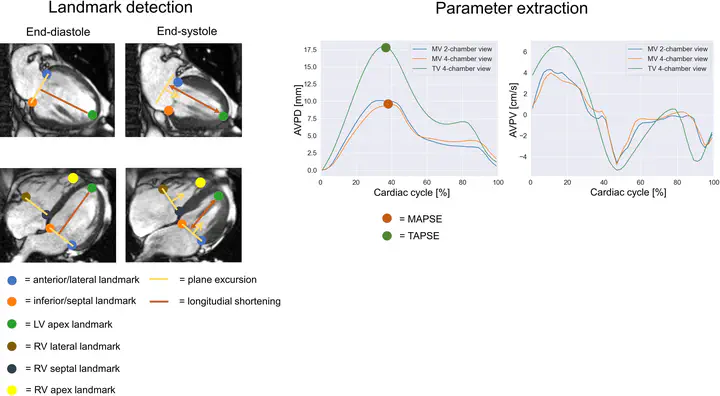Fully automated AI-based cardiac motion parameter extraction – application to mitral and tricuspid valves on long-axis cine MR images

- Overview of the target landmarks and the parameter of interest
Abstract
In cardiac MRI, valve motion parameters can be useful for the diagnosis of cardiac dysfunction. In this study, a fully automated AI-based valve tracking system was developed and evaluated on 2- or 4-chamber viewcine series on a large cardiac MR dataset. Automatically derived motion parameters include atrioventricular plane displacement (AVPD), velocities (AVPV), mitral or tricuspid annular plane systolic excursion (MAPSE,TAPSE), or longitudinal shortening (LS). Method Two sequential neural networks with an intermediate processing step are applied to localize the target and track the landmarks throughout the cardiac cycle. Initially, a localisation network is used to perform heatmap regression of the target landmarks, such as mitral, tricuspid valve annulus as well as apex points. Then, a registration network is applied to track these landmarks using deformation fields. Based on these outputs, motion parameters were derived. Results The accuracy of the system resulted in deviations of 1.44 ± 1.32 mm, 1.51 ± 1.46 cm/s, 2.21 ± 1.81 mm, 2.40 ± 1.97 mm, 2.50 ± 2.06 mm for AVPD, AVPV, MAPSE, TAPSE and LS, respectively. Application on a large patient database (N = 5289) revealed a mean MAPSE and LS of 9.5 ± 3.0 mm and 15.9 ± 3.9 % on 2-chamber and 4-chamber views, respectively. A mean TAPSE and LS of 13.4 ± 4.7 mm and 21.4 ± 6.9 % was measured. Conclusion The results demonstrate the versatility of the proposed system for automatic extraction of various valve-related motion parameters.